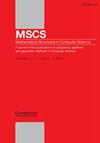加权同步自动机
IF 0.9
4区 计算机科学
Q4 COMPUTER SCIENCE, THEORY & METHODS
引用次数: 0
摘要
摘要本文介绍了一类适用于模糊系统计算范式建模的自动机及其相关语言,其中模糊性和同时性均为一等公民。这需要转换的加权语义和同步产品的精确概念,以强制操作同时发生。自动机和语言之间的通常关系在此设置中被重新审视,包括一个特定的Kleene定理。本文章由计算机程序翻译,如有差异,请以英文原文为准。
Weighted synchronous automata
Abstract This paper introduces a class of automata and associated languages, suitable to model a computational paradigm of fuzzy systems, in which both vagueness and simultaneity are taken as first-class citizens. This requires a weighted semantics for transitions and a precise notion of a synchronous product to enforce the simultaneous occurrence of actions. The usual relationships between automata and languages are revisited in this setting, including a specific Kleene theorem.
求助全文
通过发布文献求助,成功后即可免费获取论文全文。
去求助
来源期刊

Mathematical Structures in Computer Science
工程技术-计算机:理论方法
CiteScore
1.50
自引率
0.00%
发文量
30
审稿时长
12 months
期刊介绍:
Mathematical Structures in Computer Science is a journal of theoretical computer science which focuses on the application of ideas from the structural side of mathematics and mathematical logic to computer science. The journal aims to bridge the gap between theoretical contributions and software design, publishing original papers of a high standard and broad surveys with original perspectives in all areas of computing, provided that ideas or results from logic, algebra, geometry, category theory or other areas of logic and mathematics form a basis for the work. The journal welcomes applications to computing based on the use of specific mathematical structures (e.g. topological and order-theoretic structures) as well as on proof-theoretic notions or results.
 求助内容:
求助内容: 应助结果提醒方式:
应助结果提醒方式:


